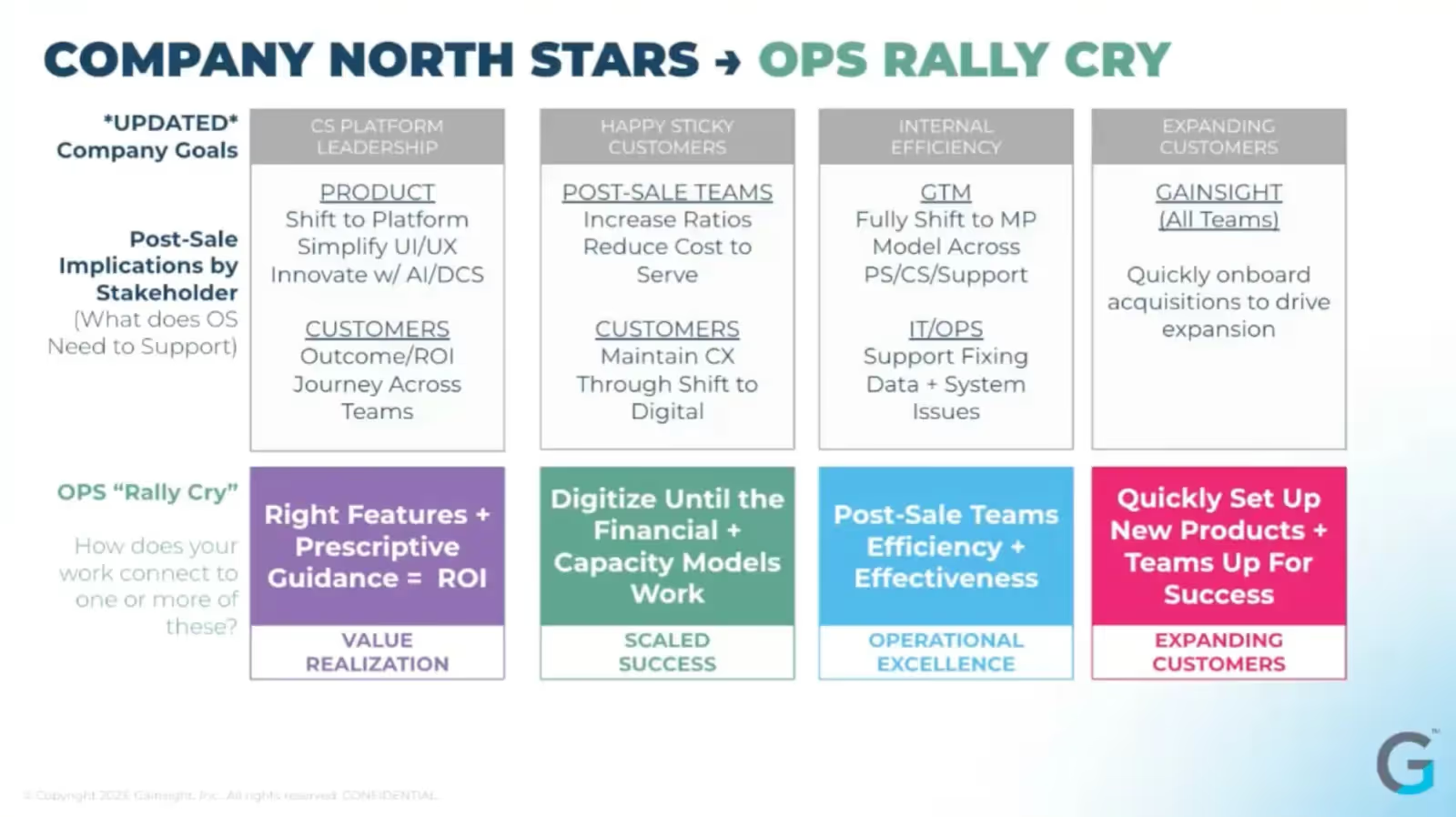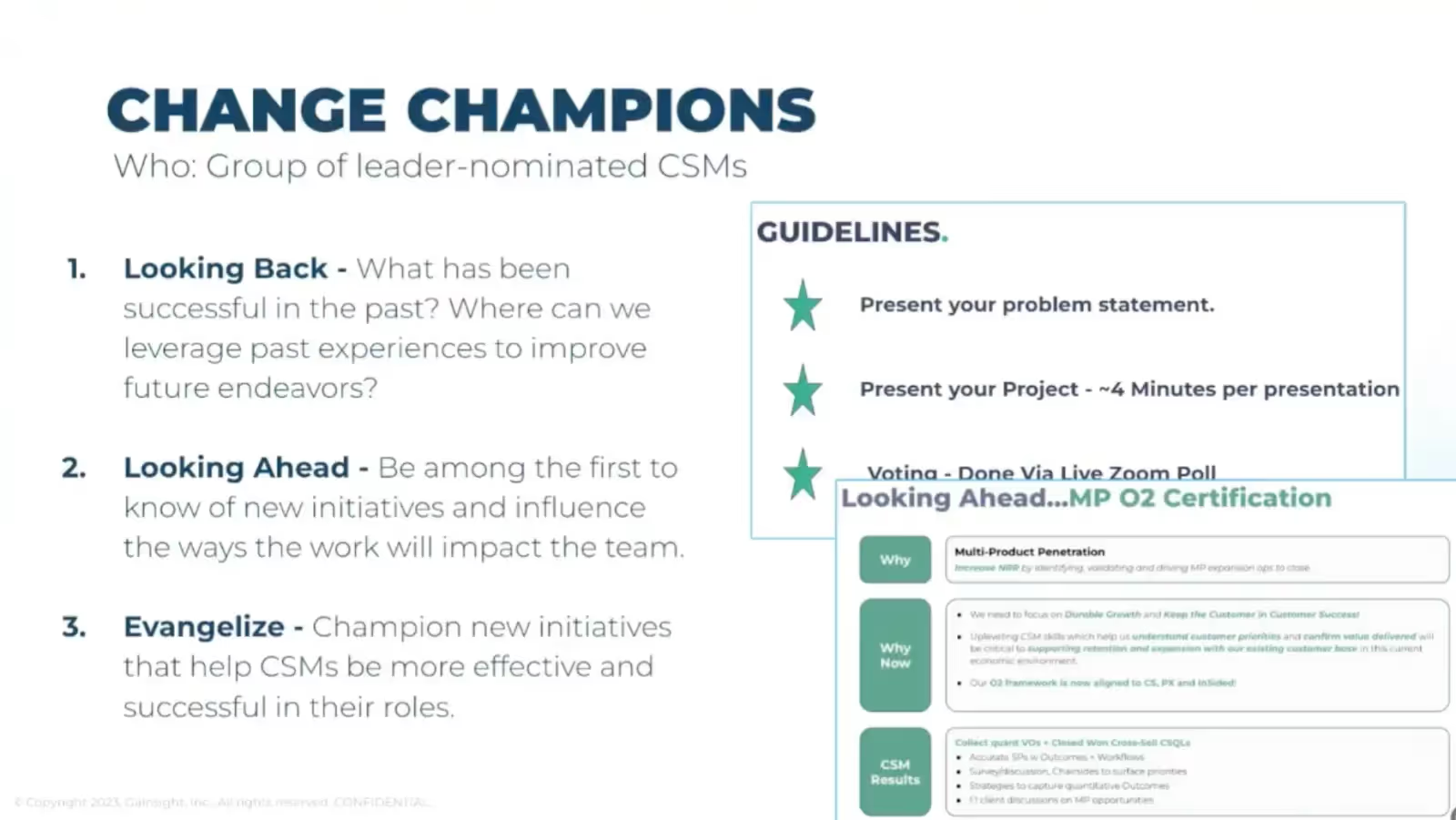Further reading
- Change management strategies during customer onboarding
- Strategies for effective implementation and packaging
- Project Management Metrics: A Comprehensive Guide
- CS and Product teams share joint KPIs to drive adoption
As organizations strive for growth and success, strategic priorities play a pivotal role in directing their journey.
Yet, these high-level objectives often seem intangible and abstract, disconnected from the day-to-day operations on the ground.
The solution to bridging this disconnect lies in a three-letter metric - KPIs. Understanding how to translate strategic priorities into measurable KPIs is a skill that not only provides a clearer vision for teams, but also facilitates progress tracking. It also aids in decision-making, and ultimately helps organizations achieve their goals.
In the third installment of the CS Ops Deep Dive series, Kendra McClanahan, Director of Customer Operations at Gainsight, shares her insights on how to turn strategic priorities into measurable KPIs.
You can watch the first two installments of the CS Ops Deep Dive here:
1. Adapting to a strategic mindset for CS Ops by Gunjan Nichani
2. Designing, mapping, optimizing post-sale processes by Jeff Beaumont
Here are the topics that Kendra discussed:
- Translating company goals into manageable team priorities
- Teammate-driven innovation
- Organizing the inputs from internal and external teams
- Measuring success and KPIs
Let’s dive in!
Exploring the 4 key value drivers
Gainsight utilizes a value framework externally and internally, encompassing four value drivers that their tools support and help customers achieve across all their products.
1. Increased expansion
Use predictive analytics and workflows to scale and prioritize efforts around renewing and expanding successful customers and decreasing revenue leakage.
2. Enhanced scale and efficiency
Align your business around a single source of truth, automate actions, and orchestrate customer engagements to ensure value delivery at scale.
3. Improved user experience & product adoption
Analyze usage and sentiment data to create targeted in-app engagements that can drive user behaviors, deliver feedback, and drive value and growth.
4. Improved retention
Understand your customers so you can proactively steer them towards value. Recognize early signs of risk, and efficiently address potential churn on a larger scale.
Translating company goals into manageable team priorities

The company’s North Star
For teams planning and executing strategies throughout the year, a great way to drive OKRs and programs is to regularly create and review your One Page Strategic Plan (OPSP).
At the beginning of each year and quarter, analyze the OPSP, determining the role of the operations team in achieving company goals. These goals can be categorized into five pillars, each typically containing three strategic goals.
Evaluate where Ops fits in and assess whether the identified goal aligns with existing programs or involves additional objectives beyond ongoing initiatives.
Determine the desired outcome of each goal and establish the criteria for measuring its achievement.
After establishing your company goals, consider the post-sale implications for different stakeholders that the Operations and Scale team must address.
For instance, one of Gainsight’s main goals is to have happy, sticky customers as well as optimized post-sales team operations. So the post-scale implication for this goal would be to focus on enhancing ratios and lowering costs to meet financial models.
The team also strives to enhance customer experience by transitioning to a digital-focused approach. This allows customers to access more resources beyond the support provided solely by Gainsight teams.
Ops ‘rally cry’
After establishing your company goals and determining your objectives, convert them into ops ‘rally cries’.
An ops ‘rally cry’ depicts how your team's work translates into action. If you have a large team, it is crucial that everyone understands how their daily tasks contribute to your company's objectives.
If we consider Gainsight’s goal of having happy sticky customers, their ops rally cry would be to digitize financial and capacity models, which is achieved through their scaled success team.
Creating rally cries fosters a sense of pride in your employees and allows them to connect their work to the company’s broader goals, even when the connection may not be immediately apparent.
Ops planning and execution
The next step involves incorporating your company goals into your project management procedures to ensure you can provide your executives with the necessary visibility.
To achieve this, you must examine your commitments for the current fiscal year and focus on displaying current progress and future actions.
This process can be implemented with various project management tools. You can start by slowly building your processes using a project management tool. Eventually, it will develop into a mature, comprehensive process that grows alongside your operations team.
With Rocketlane’s PSA tool, you can ensure that organizational goals are effectively communicated and understood while allowing for real-time updates on task statuses and milestones. This fosters a collaborative environment where team members can work together towards common OKRs, create and enforce execution playbooks, making adjustments as needed based on data-driven insights.
Teammate-driven innovation
It is important not to overlook bottom-up innovation, which makes it crucial to ensure that there is input from end users, including customer success managers (CSMs), support agents, and internal teammates.
Empowering the operations team to make decisions and suggest improvements in your processes is essential. Here are some ways to foster teammate-driven innovation.
Operationalizing teammate inputs
External team input
- Bi-weekly office hours: External stakeholders should be encouraged to share their ideas and inputs with the team during bi-weekly office hours.
- Enhancement request form: With the help of enhancement request forms, individuals have the opportunity to provide suggestions, ranging from simple requests, such as a new report or email templates, to larger projects that Customer Success Managers feel strongly about and wish to collaborate with operations team to implement and support their fellow teammates.
Ops and scale team input
- Weekly team working session: Facilitate collaboration between admins and teammates to find solutions and work together. This will help you create a comprehensive Q&A document and develop operational dashboards. These brainstorming and working sessions also help streamline many processes.
- Retrospectives: Conduct quarterly retrospectives to extract extra innovative ideas.
Champions program

The Champions program is an effective way to utilize end users for operational improvement.
Create a group of leader-nominated CSMs who are involved in bi-weekly sessions. They can utilize their insights and experiences to enhance future endeavors.
The CSMs can contribute by sharing problem statements and collectively selecting projects to champion within your organization.
The Champion’s program can also be used to facilitate the rollout of new initiatives and ensure that your teams understand the process and its impact.
Here is how a champion’s program is structured:
- Looking Back - What has been successful in the past? Where can we leverage past experiences to improve future endeavors?
- Looking Ahead - Be among the first to know of new initiatives and influence how the work will impact the team.
- Evangelize - Champion new initiatives that help CSMs be more effective and successful in their roles.
Organizing the inputs from internal and external teams
Once you have defined your goals and established your OKRs, your next step is to organize the input you have received. Given the large amount of work that must be done, you must prioritize tasks and determine which ones are feasible for you to take on and commit to the business.
Organizing your input encompasses the activities your team needs to undertake to achieve specific objectives. Additionally, it includes the tasks necessary for running the business and running programs, which are recurring responsibilities that consume a portion of your capacity each quarter.
Therefore, you need to assess your capacity based on these ongoing tasks in order to determine which objectives you can take on and ultimately reach an agreement with the business.

Cake slices
The ‘cake slice method’ could help you organize your inputs in an orderly manner. You must divide your ‘cake slices’ so that your team is not completely burnt out, yet assess and manage the workload and capacity of your team.
Dedicating all your work to strategic priorities can be overwhelming and lead to burnout. Instead, focus on one to two large strategic initiatives per quarter that are manageable for each end-user group.
Try to balance strategic initiatives and other important tasks, such as enhancing existing programs and addressing technical debt.
At the beginning of the year, the strategic slice is larger, but it becomes smaller as the year progresses, allowing more focus on running the business tasks. While these buckets may not be applicable to every organization, they help assess your team's workload and capacity.
Considering factors like holidays, PTO, and company events, can help you determine your realistic capacity for the quarter and align it with your objectives. This enables you to negotiate and prioritize tasks effectively.
Measuring KPIs and success
Metrics aligned to priorities
Measuring success is the final and most challenging aspect of project management. Understanding the impact of your projects can be difficult, especially in operational settings where results are not immediately observable.
To address this, it is crucial to consider the metrics outlined in the value framework. There are four key drivers and three types of metrics to consider: operational metrics, which can be measured presently; leading metrics, demonstrating progress towards overarching financial goals and within your team's sphere of influence; and lagging metrics, which are analyzed by your CSA analytics team to assess the impact of your actions.
Although various factors affect these metrics, you must strive to establish correlations between your team's efforts and the lagging metrics.
Focus on identifying and improving operational and leading metrics to ensure your programs move in the right direction.
Aligning value to KPIs
Identifying OKRs is crucial for your company. Your objectives should be aligned with the KPIs of your key workflows and reflect the current and target state of the company.
Let's take Gainsight’s goal of improving the expansion pipeline as an example. Their focus is on identifying opportunities for growth and driving awareness and adoption of new and existing products.
To achieve this, the team engages in various activities such as customer success, generating qualified leads, and tracking progress.
It is crucial to ensure that the OKRs you set are linked to relevant metrics. If you cannot connect a process to an important company metric, it may be necessary to reevaluate whether it is the right area of focus for your team. There may be more impactful initiatives that could contribute to your top company goals.
Bring visibility to your impact
It is important to emphasize the impact of your work to justify the need for a large operations team. Build a process for measuring and communicating the results of everything you do.
Focus on leading indicators and find a way to measure the impact on the desired outcome, such as increasing account ratios. You can observe positive trends in the value of high activities for CSM, CSAT scores, and health score accuracy.
It's essential to not only consider the processes carried out, but also to have a means of measuring their effectiveness.
CS Ops: Admin metrics
Two metrics that admin teams can use to assess the efficiency and effectiveness of the post-sales team are related to data fixing in the system. Ask yourselves if you are addressing data issues promptly so that your CSMs can perform their duties effectively.
Your admins can review the tickets and take ownership of the ones that fall under their responsibilities. They can collaborate with other ops teams such as IT, and Product Operations to address and resolve these issues.
While some issues may take longer to resolve, particularly those related to products or other teams, measure and track all this data on a weekly basis. This provides valuable operational insights that we share with the organization.
CS Ops: Survey metrics
Another operational metric that you can track is quarterly surveys conducted among your CSMs, support agents, and professional services team.
Through these surveys, you can gauge the impact of the processes you have implemented and assess if they are achieving their intended goals. The survey employs a one-to-five scale, allowing team members to indicate their level of agreement or disagreement.
You can also analyze trends to ensure you are moving in the right direction. If any areas show a decline, discuss them with the leadership team during your steering committee meetings and determine the priorities for improvement.
Leading metrics
If your organization is focused on digital events, key KPIs should include boosting adoption ratios and cutting down the cost to serve.
Your team must work on organizing and executing digital events. They can collaborate internally with presenters and automate data from webinars into your customer success platform.
Doing this allows us to measure the impact of these events on adoption rates. For example, if you host an event showcasing a particular feature, you can analyze whether there is an increase in its adoption.
Another aspect you should consider is the number of customers attending these events.Doing so allows you to assess the time saved for CSMs who don't have to meet with customers individually on specific topics.
You can quantify this time and evaluate it in terms of full-time equivalents (FTEs). This will help you understand the impact on the number of customers a CSM can effectively support over time.
Lagging metrics
Your CSA analytics team should analyze the various programs you are implementing. Examine how these programs affect retention, NPS, and other lagging metrics.
Gainsight, for example, used their value framework to understand their goals and track verified outcomes while working with their customers. Recording information about customers who achieved their goals revealed that those with a verified outcome during their renewal year exhibited a 30% higher GRR rate than those without a verified outcome.
This confirms that this process, driven by the CSMs, directly impacts customer renewals and helps you prioritize those with or without verified outcomes.
Try Rocketlane to track your strategic priorities
When it comes to turning strategic priorities into measurable KPIs, having the right tools can make all the difference. That's where Rocketlane's PSA tool comes in.
Rocketlane PSA is designed to streamline the process of aligning your strategic priorities with measurable KPIs. It provides a centralized platform where you can define your strategic objectives and break them down into specific goals and tie them to metrics. This helps you clearly define your goals and ensures everyone on your team is on the same page.
Rocketlane also allows you to track and monitor the progress of your goals in real-time. With customizable dashboards and reports, you can easily visualize the performance of your strategic priorities and make data-driven decisions.
Enjoy collaboration and transparency within your team with Rocketlane. You can assign tasks, set deadlines, and track progress, ensuring everyone is accountable for their responsibilities.
Rocketlane PSA is a valuable asset for any organization looking to turn their strategic priorities into measurable KPIs. It provides a seamless and efficient way to align your goals, monitor progress, and drive success.
Try Rocketlane and achieve your strategic goals seamlessly! Book a demo today!
FAQs
1. What are KPIs?
KPIs, or Key Performance Indicators, are metrics used to measure the success of an organization in achieving its strategic goals.
2. Why is it important to turn strategic priorities into measurable KPIs?
Turning strategic priorities into measurable KPIs ensures that there is a clear framework for tracking progress and measuring success. It helps organizations stay focused and provides a means for evaluating performance.
3. What makes a KPI effective?
Effective KPIs are specific, measurable, achievable, relevant, and time-bound (SMART). They should provide clear, actionable data aligning with the organization's strategic priorities.
4. How do you define measurable KPIs?
Measurable KPIs are defined by establishing clear metrics and targets that can be tracked and quantified. They should provide objective data and allow for comparison over time.
5. What are some examples of strategic priorities that can be turned into measurable KPIs?
Examples of strategic priorities that can be turned into measurable KPIs include increasing customer satisfaction, improving employee retention rates, reducing operational costs, and increasing market share.
6. How often should KPIs be reviewed?
KPIs should be reviewed regularly to track progress and make necessary adjustments. The frequency of reviews may vary depending on the specific organization and its goals, but quarterly or monthly reviews are common.

























.webp)